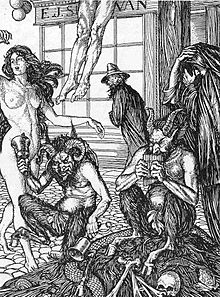- Sartor Resartus
-
 Teufelsdröckh in Monmouth Street, illustration to Sartor Resartus by Edmund Joseph Sullivan.
Teufelsdröckh in Monmouth Street, illustration to Sartor Resartus by Edmund Joseph Sullivan.
Thomas Carlyle's major work, Sartor Resartus (meaning 'The tailor re-tailored'), first published as a serial in 1833-34, purported to be a commentary on the thought and early life of a German philosopher called Diogenes Teufelsdröckh (which translates as 'god-born devil-dung'), author of a tome entitled "Clothes: their Origin and Influence" , but was actually a poioumenon.[1] Teufelsdröckh's Transcendentalist musings are mulled over by a skeptical English editor who also provides fragmentary biographical material on the philosopher. The work is, in part, a parody of Hegel, and of German Idealism more generally. However, Teufelsdröckh is also a literary device with which Carlyle can express difficult truths.
Contents
Publication history, themes and critical reception
Because Carlyle had difficulty finding a publisher for Sartor, he began composing it as an article in October 1831.[2] Fraser's Magazine serialised it in 1833-1834 and the text was published as an independent volume in Boston in 1836 and London in 1838.[3]
Sartor Resartus was intended to be a new kind of book: simultaneously factual and fictional, serious and satirical, speculative and historical. It ironically commented on its own formal structure, while forcing the reader to confront the problem of where "truth" is to be found. In this respect it develops techniques used much earlier in Tristram Shandy, to which it refers. The imaginary "Philosophy of Clothes" holds that meaning is to be derived from phenomena, continually shifting over history, as cultures reconstruct themselves in changing fashions, power-structures, and faith-systems. The book contains a very Fichtean conception of religious conversion: based not on the acceptance of God but on the absolute freedom of the will to reject evil, and to construct meaning. This has led some writers to see Sartor Resartus as an early existentialist text.
Sartor Resartus had a limited success in the USA, where it was admired by Ralph Waldo Emerson, influencing the development of New England Transcendentalism, and by Herman Melville, whose Moby-Dick was strongly influenced by Carlyle. Dwight Eisenhower, who kept this book with him from 1942 through 1945 while Commander of the Allied Expeditionary Force, noted “It is a wise man who has read this masterpiece and acts upon its call.”[citation needed]
Characters and locales
Blumine
The siren who, Calypso-like, seduced Teufelsdroeckh at the commencement of his career, but who also helped him see that it is not in sentiment, however fine, that the soul's cravings can find satisfaction.[4]
Dumdrudge
Dumdrudge is an imaginary village where the natives drudge away and say nothing about it, as villagers all over the world contentedly do.[5]
Hofrath
Hofrath Heuschrecke (i. e. State-Councillor Grasshopper) is a loose, zigzag figure, a blind admirer of Teufelsdroeckh's, an incarnation of distraction distracted, and the only one who advises the editor and encourages him in his work; a victim to timidity and preyed on by an uncomfortable sense of mere physical cold, such as the majority of the state-counsellors of the day were.[6]
Weissnichtwo
In the book, Weissnichtwo (weiß-nicht-wo, German for don't-know-where) is an imaginary European city, viewed as the focus, and as exhibiting the operation, of all the influences for good and evil of the time, described in terms which characterised city life in the first quarter of the 19th century; so universal appeared the spiritual forces at work in society at that time that it was impossible to say where they were and where they were not, and hence the name of the city, Don't-know-where (cf. Sir Walter Scott's Kennaquhair).[7]
References
- ^ Fowler, Alastair. The History of English Literature, p. 372 Harvard University Press, Cambridge, MA (1989) ISBN 0-674-39664-2
- ^ Fred Kaplan, "Carlyle, Thomas (1795–1881)", Oxford Dictionary of National Biography, Oxford University Press, 2004; online ed., 2008, accessed 10 Jan 2011.
- ^ Campbell, Ian. "Thomas Carlyle." Victorian Prose Writers Before 1867. Ed. William B. Thesing. Detroit: Gale Research, 1987. Dictionary of Literary Biography Vol. 55. Literature Resource Center. Web. 10 Jan. 2011.
- ^
 This article incorporates text from a publication now in the public domain: James Wood (1907). "Blumine". The Nuttall Encyclopædia.
This article incorporates text from a publication now in the public domain: James Wood (1907). "Blumine". The Nuttall Encyclopædia. - ^
 This article incorporates text from a publication now in the public domain: James Wood (1907). "Dumbdrudge". The Nuttall Encyclopædia.
This article incorporates text from a publication now in the public domain: James Wood (1907). "Dumbdrudge". The Nuttall Encyclopædia. - ^
 This article incorporates text from a publication now in the public domain: James Wood (1907). "Heuschrecke, Hofrath". The Nuttall Encyclopædia.
This article incorporates text from a publication now in the public domain: James Wood (1907). "Heuschrecke, Hofrath". The Nuttall Encyclopædia. - ^
 This article incorporates text from a publication now in the public domain: James Wood (1907). "Weissnichtwo". The Nuttall Encyclopædia.
This article incorporates text from a publication now in the public domain: James Wood (1907). "Weissnichtwo". The Nuttall Encyclopædia.
External links
- Sartor Resartus: the life and opinions of Herr Teufelsdrocke ++ at Project Gutenberg
 Archibald MacMechan (1920). "Sartor Resartus". Encyclopedia Americana.
Archibald MacMechan (1920). "Sartor Resartus". Encyclopedia Americana. James Wood (1907). "Sartor Resartus". The Nuttall Encyclopædia. In addition to the article on Sartor Resartus, there are many themes and ideas from Sartor Resartus cited in this work, of which the citations in the article above are only a small sample.
James Wood (1907). "Sartor Resartus". The Nuttall Encyclopædia. In addition to the article on Sartor Resartus, there are many themes and ideas from Sartor Resartus cited in this work, of which the citations in the article above are only a small sample.
Categories:- Existentialist novels
- 1833 novels
- Works by Thomas Carlyle
- Novels first published in serial form
- Works originally published in Fraser's Magazine
Wikimedia Foundation. 2010.
